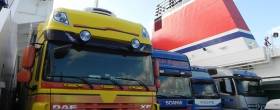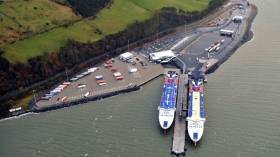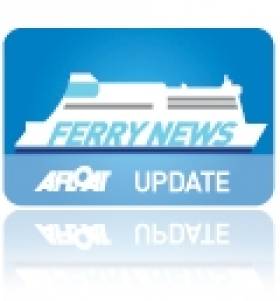Displaying items by tag: Stena Line
Departing Barge Marks Final Chapter of Stena’s Association With Dun Laoghaire
#FinalLink – The final chapter of Stena Line’s history with Dun Laoghaire Harbour was marked this morning when a barge used to dismantle the former HSS berth departed under tow, writes Jehan Ashmore.
MTS Indus towed the barge SB-5018 that was used in the harbour as a floating platform. The red-hulled barge was moored next to the ferry terminal linkspan at Berth No. 5 on St. Micheals Pier.
The specialist custom built linkspan for berthing operations of HSS Stena Explorer lasted for almost two decades of the Dun Laoghaire-Holyhead route that closed two years ago this month. The loss-making route led Stena to consolidate existing operations out of neighbouring Dublin Port on a route also to the north Wales port.
Dun Laoghaire Harbour Company are looking for a new operator to restore the seasonal service next year, but using the adjacent Berth No. 4 alongside St. Micheals Pier. This linkspan was last used in 2011 by a smaller fast-ferry, Stena Lynx III.
Originally the plan was to tow the Stena HSS linkspan away from the port, by placing on board the barge, however the breakers torch was used instead on site at the ferry terminal.
This is where the Swedish registered barge also acted as a support to the specialist linkspan (see yesterday’s report photo) from where the tug departed and is under way ironically bound for Holyhead. The port in Anglesey is operated by the Swedish owned ferry operator whose headquarters are based in Gothenburg.
Dismantling work by the contractors in Dun Laoghaire had begun earlier this summer to remove all Stena owned berth infrastructure at the site of the purpose built ferry terminal. This paved the way for the introduction of the revolutionary HSS Stena Explorer fast-ferry catamaran craft in 1996.
Asides the linkspan, gone are now the passenger gangways and associated equipment at No 5 berth. The concrete supporting columns of the gangway however remain as well as the jetty and associated dolphin structure.
Not all the dismantling work was carried out on the barge. Other parts were broken up onshore from where vehicles from the HSS Stena Explorer used to disembark or arrive at the marshalling area. It was from here that awaiting trucks were loaded to be disposed by scrap merchants.
Stena Posts 6.5% Car Increase On Irish Sea
#FerryStrong - Ferry firm Stena Line writes the Belfast Telegraph, has during the month of July rounded off a "strong first six months" for the year.
Car volumes rose by 3% between January and June.
Orla Noonan, Stena Line's head of travel (Irish Sea), added: "Traditionally, July is a very busy month for us across the Irish Sea as we enter our peak season, but to post a 6.5% year-on-year increase in our car volumes pays tribute to the quality of the service we operate."
The ferry company carries around 2.2 million passengers and 614,000 cars across the Irish Sea each year.
Stena has several services from Northern Ireland, Belfast to Cairnryan, Liverpool and Heysham.
In addition Afloat adds to Republic of Ireland services: Dublin to Holyhead and Rosslare-Fishguard, noting the Wexford port also has a Stena service to Cherbourg, France.
The continental route is not included in the figures above.
Northern Ministers Tour Stena Line Port Operations
#MinistersTour - Northern Ireland's Infrastructure Minister Chris Hazzard and Finance Minister Máirtín Ó Muilleoir toured Stena Line’s port operations in Belfast Harbour.
The Ministers on Monday had the opportunity to see the impact of significant investment by Stena Line operations in the North including their £5 million ship refit investment programme. The work having been carried out locally at the Harland & Wolff shipyard.
Infrastructure Minister Chris Hazzard, whose department has responsibility for ports policy said: “Our ports are the gateway to the global economy so it is essential that they are effective and efficient. This enables them to compete internally and connect with the rest of the world.
"Stena Line’s significant investment demonstrates a clear commitment to their operations here in the north and the key role they play in the maritime sector.
“It makes sense to have a strong link between public sector infrastructure priorities and private investment plans. I want to deliver improved transport links between ports and their hinterlands to core transport routes in the north.”
Finance Minister Máirtín Ó Muilleoir said: “Today’s visit is a welcome opportunity to see first-hand the significant contribution Stena Line is making to the maritime sector. This latest investment signals their continued commitment to operations here and highlights the vital role Stena Line plays in maintaining our strategic trade links with the rest of the world. Furthermore, it demonstrates the important impact investing in our infrastructure can have, not only as a boost to the wider economy, but to local communities who benefit through job creation and skills development.”
Paul Grant, Stena Line’s Route Manager said: “Stena Line is pleased to welcome both Ministers to its port operations in Belfast. Over the last number of years Belfast has become an increasingly important hub for Stena Line freight and tourism volumes into Northern Ireland so it’s important that we communicate this ongoing development to key figures in the NI Assembly such as Ministers Hazzard and Ó Muilleoir.
Encouraged by Sustainability Report Findings at Stena Line
#CO2reduced - Strategic efforts to reduce its environmental footprint at Stena Line is well on course according to a recent company report. Last year the ferry operator cut emissions of sulphur by 53%.
Stena AB’s Sustainability Report for 2015, which was recently published, shows reduced fuel consumption and lower emissions for the shipping companies within the shipping group. Stena Line has exceeded its targets for reduction of emissions of both sulphur and CO2.
One of the largest changes to affect the shipping industry was introduced in 2015 with tough new regulations on sulphur emissions being laid down for ferry operators in Northern Europe. This regulation means that the permitted emission levels of sulphur from vessels has been reduced from a maximum 1 per cent to 0.1 per cent within the SECA area from January 1st 2015.
For Stena’s shipping companies, with 93 vessels operating all over the world, the new rules have resulted in a reduction of over 4,000 tonnes of sulphur from 2014 to 2015, which represents an impressive 15 per cent reduction. For Stena Line’s 34 vessels operating in Europe, 24 of which operate within the SECA area, the total emission of sulphur has been reduced by 53 per cent.
Carl-Johan Hagman, CEO at Stena Line, said: “Focusing on sustainability is not only a priority for Stena Line, but for the entire industry which needs long term sustainable fuel options to maintain its competiveness. We are currently conducting several initiatives looking at alternative fuels within Stena. Our Methanol Project on Stena Germanica is one example. We are also looking at battery powered vessels, which is now starting to become an interesting option for shipping.
“Since 2015 Stena’s shipping companies have been delivering a dedicated program called the Energy Saving Programme (ESP), to reduce fuel consumption. The target is a reduction of 2.5 per cent annually and the result for 2015 was a reduction of 2.8 per cent. For Stena Line the efforts led to a reduction of fuel consumption of 4 per cent per nautical mile and a reduction of CO2 emissions of 2.5 per cent per nautical mile,” concluded Carl-Johan.
Erik Lewenhaupt, Head of Sustainability, Stena Line, said: “We have a broad scope and are currently driving several different initiatives in a bid to reduce our fuel consumption within ESP. It covers everything from changing bulbs and propellers to enabling our ferries to sail with reduced water resistance. Other initiatives include using digital solutions such as our Fuel Management System, where we collect a huge amount of data from the systems onboard our 34 ferries which is them analysed and used to optimise our day to day operations. We have set an ambitious target of trying to reduce CO2 emissions by 35% per nautical mile by 2030.”
Stena Line Cairnryan Port Valuation taken to Tribunal
#ValueContested - Stena Line is contesting the £1.25m rateable value set on its ferry port in Cairnryan, claiming it could compromise future site investment.
BBC News writes that an appeal against the Assessor for Dumfries and Galloway will go to the Lands Tribunal for Scotland in July.
The company claimed the new rate was "effectively double" what it paid at its old site in Stranraer.
Assessor Keith Mossop described the hearing as "really just a procedural matter."
Stena Line moved its operations to the site in 2011 after it left its facilities in nearby Stranraer.
It said it had been in "protracted negotiations" in relation to the rates assessment at the new port.
"Stena Line made a significant investment (in excess of £80m) when it opened its new state-of-the art ferry port and terminal at Cairnryan in 2011 to replace its former Stranraer facility," said a statement.
"Despite this investment, designed to provide south west Scotland with a modern freight and tourism gateway, the council has assessed Stena Line for its non-domestic rates for the new port at a rate effectively double that of its former facility.
"Stena Line is concerned that this significant additional running cost may impact upon future investment at Loch Ryan Port."
For more on the south-west Scottish ferryport, click here
Contract Signed for Four New Stena RoPax Ferries
#RopaxOrder - An order for four new RoPax ferries subject to Stena board approval by end of April are planned for delivery during 2019 and 2020, with an option for another quartet of vessels.
The vessels will be optimized for efficiency and flexibility and will be built by AVIC Shipyard in China. The intention is that the four initial vessels will be used within Stena Lines route network in Northern Europe.
“We are very pleased that Stena have signed a contract for four vessels with an option for another four. During the course of the past 24 months our engineering staff has managed to develop a design that is not only 50% larger than today’s standard RoPax vessels, but more importantly, incorporates the emission reduction and efficiency initiatives that have been developed throughout the Stena Group during the past years. These ships will be the most fuel efficient ferries in the world and will set a new industry standard when it comes to operational performance, emissions and cost competitiveness, positioning Stena Line to support its customers in the next decades”, says Carl-Johan Hagman, Managing Director of Stena Line.
The vessels will have a capacity of more than 3 000 lane meters in a drive-through configuration and will accommodate about 1 000 passengers and offer a full range of passenger services. The main engines will be “gas ready”, prepared to be fueled by either methanol or LNG.
“With this investment we are building on our successful RoPax concept mixing freight and passengers. Through standardization we secure a reliable operation and through flexibility we can provide an even better support to our customers and help them to grow”, says Carl-Johan Hagman.
“We foresee a continued demand growth for short sea services in Northern Europe and in many other parts of the world. Ferry transportation will play an essential part in shaping tomorrow’s logistics infrastructure if we are to have sustainable societies. Not only is transportation on sea the most environmentally efficient way of moving goods, it is also infrastructure that provides reliable and speedy logistics with very limited public cost. Through this investment we prepare Stena Line for further growth”, says Dan Sten Olsson, Chairman in Stena Line.
20th Anniversary Celebrates Stena's Dublin-Holyhead Route
#StenaDublin20th - On this day 20 years ago, Stena Line began operating an inaugural sailing of its flagship on the Dublin-Holyhead route, writes The Irish Independent.
The anniversary was celebrated in Dublin Port today with model and presenter Vogue Williams posing for photos on the company's Superfast X ship.
"The demand for this route has grown significantly since November 1995 and we now travel from Dublin to Holyhead and back four times daily," said Orla Noonan, Head of Travel at Stena Line Ireland.
20 isn't the only number circulated in a press release marking the occasion. In two decades, Stena has operated 39,000 sailings, carrying 8.9 million people on the route. For more click here.
Afloat adds that another significant '20' was marked this day last week as the operator also celebrated two decades of ferry services out of Belfast Port.
Belfast Port Key to Two Decades of Stena Services
#StenaBelfast20th - This year marks twenty years since Stena Line took up its ferry services in Belfast and 2015 is to be the operators busiest year to date for car and freight numbers.
In the two decades since it moved to Belfast on this day in 1995, Stena Line has expanded its services significantly. Currently the company employs over 900 staff, transports 1.4 million passengers, 318 000 cars and almost 500 000 freight units annually.
When the ferry firm established its Belfast operation on 12th November 1995, it operated three ferries to one port in Scotland. (See recent ferry award for Belfast-Cairnryan). Today, that service has expanded to seven vessels operating year round services to Cairnryan, Birkenhead (Liverpool) and Heysham with a mix of freight and leisure traffic.
Stena Line has delivered some impressive numbers on its Belfast services over the last two decades including transporting 26 million passengers, 5.5 million cars and over 4 million freight units. But as Route Manager (Irish Sea North) Paul Grant states, behind the numbers it’s the quality and reliability of the service that has been the hallmark of Stena Line’s successful Belfast operation, commenting: “The opportunity to develop a significant presence in Belfast was always going to be based on how well we developed our customer offering. Today our modern fleet offers a range of quality facilities have helped to set the standard for travel on the Irish Sea including Spa facilities, exclusive Plus lounges, family suites and dedicated Freight Driver lounges. When these facilities are back up by award winning crews and market leading punctuality and reliability figures, the next two decades look equally as exciting.”
The company has also taken a positive view of the development of the local economy over the last two decades. Hans Nilsson, Stena Line’s Chief Operating Officer (COO) said: ”Stena Line and the Stena Group are long term supporters of Belfast. Over the last two decades alone, working in partnership with Belfast Harbour, we have invested over £330 million in establishing and developing our services to and from Belfast. In fact this week we will have an eighth Stena vessel in Belfast with the 117 000 ton ice-breaker series Stena Arctica undergoing a major refit at Harland & Wolff, further testimony of support for and confidence in the local Northern Ireland economy.”
A number of notable milestones over the last two decades in Stena Line's Irish Sea North have including the construction of a new £35 million VT4 terminal in Belfast in 2008. Three years later in 2011 the company established a new port and terminal facility at Loch Ryan Port (Cairnryan) adding two award winning Superfast vessels. In the same year it also acquired the Belfast-Liverpool/Heysham routes from DFDS.
Ferry Good Award to Stena in Scotland
#ScottishFerryAward- The best ferry operator award went to Stena Line at the Scottish Passenger Agents’ Association Travel Awards (SPAA) 2015, reports The Stornaway Gazette.
The ferry firm is the market leader on the Irish Sea, carrying approximately three million passengers on its UK-Ireland routes each year, more than its rival ferry operators combined.
SPAA, the world’s oldest travel organisation, holds the awards annually to recognise excellence in Scotland’s travel industry and Stena Line has received the best ferry operator accolade a number of times.
For more click the link to the regional newspaper here.
#BerthingTrials - Stena Superfast X made her first ever call to Dublin Port today, where berthing trials of the new Holyhead route ferry took place in the Irish capital, writes Jehan Ashmore.
The berthing trial-run at Ferry Terminal 2 saw the 1,200 passenger / 480 car capacity ferry complete the exercise before lunctime. She then departed for the return leg to her Wales homeport, where the 30,285 tons made her delivery voyage to Holyhead last week fresh from a major refit in Poland.
She is to be named in Dublin Port next week at Berth 51, where a combined naming ceremony and official launch is to take place at that terminal. Superfast will partner the route's Stena Adventurer which too was named alongside Berth 51 in 2003, then the new two tier ro-ro ramp was also officially opened on that occasion.
With no fewer than 10 decks, Stena Superfast X will offer passenger facilities among them family lounges featuring X-Box stations. In addition, a dedicated lorry drivers lounge and almost 2kms of lane space to boost capacity for vehicles and freight traffic.
Stena Superfast X will make two return sailings daily, completing the crossing in 3 hours and 15 minutes. Together she and Stena Adventurer will operate 28 return sailings weekly.
The newcomer is the only Stena Irish Sea ferry to be registered in the Welsh capital, Cardiff. Unlike predecessor 'Nordica' (soon to be displaced) and Stena Adventurer are both registered in London.
Superfast X will join an existing pair of Stena's Irish Sea serving sisters, Superfasts VII and VIII which in 2011 entered between Cairnryan-Belfast, from where they are registered.
































































